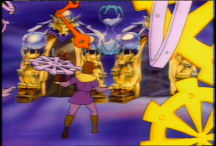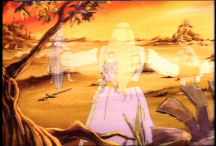Here’s a puzzle. In 1984, RDI Video Systems released a
laserdisc adventure game for arcade consoles called Thayer’s Quest
(the first part of a planned two-part series). Part two of Thayer’s
Quest was never completed because the company went into bankruptcy.
Then, in 1997, an updated Windows version of the game was published.
This version was called Kingdom: The Far Reaches, and in it the
names of the characters were changed, puzzles and a map were added and for
the first time you could save the game. A sequel was released at about the
same time – Kingdom 2: Shadoan, which completed the quest left
unfinished at the end of Kingdom: The Far Reaches.*
Digital Leisure recently decided to re-release the game on PC for
those among us who love to play the adventure classics. And which version
of the game did they choose to re-release? The updated Kingdom: The Far
Reaches? No, instead they released the older, more restricted
Thayer’s Quest. Why? We may never know the answer to that question.
The Hero Apprentice
Thayer’s Quest is a fantasy cartoon adventure featuring third
person perspective and a point-and-click interface. It takes place in
three ancient, medieval-style kingdoms. Our hero is an apprentice magician
sent on a seemingly impossible quest to reunite five relics to form a
magical amulet. Once the amulet is whole, Thayer will attempt to defeat
the evil wizard Sorsabal, who threatens to hold the land in thrall. And
along the way Thayer will discover the truth about his heritage. It’s
familiar fantasy story territory, and it works. It doesn’t take long
before you are eager to help guide this young hero to the culmination of
his quest.
1984 – A Good Year for Adventure?
The first surprise about this game is that it doesn’t look like a game
developed in 1984. The graphics are light-years ahead of those in
King’s Quest 1: Quest for the Crown, which was released in the same
year.
Unfortunately, the graphical resolution in Thayer’s Quest is
sharpest when played in a window that’s only four inches by six inches,
which makes searching for inventory items painfully difficult. Expanding
the window to about seven by twelve inches makes the gameplay easier,
though this does muddy the graphics a bit. In this larger window, the game
world (though slightly blurry and more pastel hued) is still appealing,
with lots of fantastical details to observe – gold leafed forests,
spectral swamp creatures, statues that come to life.
Atypically for an adventure game, in Thayer’s Quest you don’t
roam around and explore the game environment. Each screen opens with an
animation involving the inhabitants, whether townspeople, members of a
royal court, dryads, fairies, or dread guardians. The animation is
impressive. When the animation ends, you make a choice – you can search
the screen for items, open up Thayer’s pouch to use an inventory item, or
travel to a different location. Angles are cinematic, and cleverly chosen
to reduce the need for lip sync during dialogs. Dialogs do not have
subtitles. Background music varies in each location and consists of a
pleasant wash of sound that plays during each animation. Sometimes the
music has medieval elements. Other times it is ominous and generally epic
in character -- similar to other music from the ‘80s created on a
synthesizer for fantasy style cartoons.
Thayer seldom holds a sustained conversation with anyone. He may ask a
question or say hello, but the other person simply announces a bit of
information, issues a threat or articulates a warning.
Typical dialog:
Thayer: “Can you help me?”
Dryads: “In the castle of crystal, behind bronze is knowledge, behind
crystal is magic, and blackness leads to death.”
(End of conversation.)
Voiceovers are quaint – you’ll hear rough accents with quirky
intonation from the peasants and fairy folk. These contrast with
aristocratic accents from the royals. In addition to the living creatures,
you’ll encounter a couple of ghosts who materialize to give advice. And at
random moments a black magician pops in to try and kill you.
Oh Death, I Feel Thy Sting, Sting, Sting, Sting…
Speaking of death – you will experience it a lot in Thayer’s Quest.
In fact, I died and dead-ended repeatedly. There is no way to save the
game. So when you realize that you have reached a dead end, you must start
again from the beginning and play all the way through to the point where
you left off. (Playing this game provides an eye-opening lesson in the
improvements in gameplay since the early days of PC gaming. Again the
question arises – why re-release the non-updated version in which the
player cannot save the game to reduce the risk of repeated dead ends?)
Challenges consist of wisely managing your inventory. First you have to
find the items. The cursor doesn’t highlight to show hotspots, so you
click on the screens randomly to search them. You can only carry a small
number of items, and the time will come when you have to discard something
you are carrying in order to pick up a new item. Through experimentation,
you’ll figure out which items can be picked up again and which can’t
(discarding the wrong item leads to a dead end). Also, you must learn to
avoid traveling to the locations that are nothing more than death traps.
Then there are the places where you die if you have not yet found the
right inventory item to use against a foe -- or if you are foolish enough
to select the wrong item when the time comes to choose. These obstacles
can eventually be overcome by trial and error. Sometimes you receive hints
as to what item will work and where, and this cuts down a trifle on the
dying. Although Thayer engages in a couple of brief combat sequences, you
do not have to guide these sequences or involve yourself in the fighting.
You just watch the animation as Thayer vanquishes his foe using the
correct inventory item (or, if you haven’t chosen the right item, you will
find yourself at the “You have Died” screen).
Then there are the places where you can wrongly use an inventory item
-- and this misuse makes the item disappear. Such places are far worse
than the death traps, because the missing item then can’t be used in the
appropriate place later in the game. When, for instance, you realize that
you have foolishly used a spell scroll in the wrong place, you must start
the game over again. Occasionally the speed with which you access the
inventory is timed – if you are slow to click on Thayer’s inventory pouch
you will die, which may or may not result in having to start the game from
scratch.
Why You’ll Need to Leave Home
At the beginning of the game, you are allowed to select either the
“Home” version of the game or the “Arcade” version. Home mode gives you
unlimited lives and allows you to scroll through the inventory at your
leisure. Arcade mode gives you only five lives – after the fifth death you
have to start the game again. Arcade mode also makes scrolling through the
inventory a timed challenge – you must not only be quick to click on
Thayer’s pouch, but often you must also scroll through the inventory at
lightning speed. Distraction or hesitation results in death or a dead end.
You can use Home mode to become conversant with the game before taking
on the Arcade challenge. But why bother with the Arcade challenge?
Well, while playing innocently along in Home mode, and after restarting
the game about thirty times to reach the conclusion, I finally came to the
final bridge with the correct toll to pay the guardian. Heart beating
wildly, I attempted to cross, but then learned that the bridge wasn’t
crossable in Home mode. Crossing the bridge could only be accomplished by
a gamer playing in Arcade mode. I concluded that the game designers are,
shall we say, mischievous.
Then I replayed repeatedly in Arcade mode, managed to finally cross the
bridge, and … concluded that the game designers are, shall we say, cruel.
The End Game (Such as it Is)
The ending sequence is immensely frustrating, perplexing, and downright
odd.
Spoiler: Crossing the final bridge in Arcade mode means you
have completed the game. But you haven’t completed the quest. You have
only three of the five items needed for the amulet, and you haven’t had
your final showdown with the evil Sorsabal. Your only reward for finishing
Thayer’s Quest is an advertisement for Kingdom 2: Shadoan.
This doesn’t make a whole lot of sense. Kingdom 2: Shadoan
hasn’t been on store shelves for years. It appears to only be available on
eBay or through the Digital Leisure online store. Not to mention that
Shadoan is a sequel to Kingdom: The Far Reaches – not a sequel
to Thayer’s Quest.
End Spoiler
Thayer can’t complete his quest. And neither can you.
Quick List for Thayer’s Quest
Point-and-click interface, third person perspective – a PC version of a
classic console game. Nice medieval cartoon fantasy graphics; locations
are a single screen only. The game window uses approximately half of the
screen. Lots of animations, which are professionally crafted (amazing for
a game that is more than twenty years old). Story is familiar fantasy
stuff, but provides an effective hook. Reasonably good voiceovers, brief
dialogs full of symbolic descriptions with a quasi-medieval tone. No
subtitles.
One of the worst endings in gaming.
Inventory challenges and constant dying. You’ll watch a bit of combat,
but don’t have to guide it. Some of the challenges are timed, especially
when in Arcade mode. No sliders, no real mazes, no tone-matching, no color
discrimination puzzles. The hardest part of the game is managing the
inventory, remembering what to do in each location and performing the
action quickly enough. One difficult pixel hunt.
Occasional dead ends – you will probably repeat the game over and over
in order to find your way to the end. Two playing modes. You can only
“finish” the game in the more difficult (Arcade) mode.
No glitches, no ability to save the game. Appropriate for ages ten and
up. If you don’t mind having to start the game over again and again, it
can be fun to play as a family.
Thayer’s Quest is aimed at gamers who enjoy playing classic
adventures and can forgive the dying and restarting. Buy it if you suffer
from Collect All Adventure Games Syndrome. But be aware that this game
comes to an end when Thayer is only halfway through his quest.
Final Grade: C
My Computer Specs:
Windows XP Professional
Pentium 2.80 GHz
2046 MB RAM
Direct X 9.0c
512 MB NVIDIA GeForce 7800 GTX
SB X-Fi Audio
*Source for the history of Thayer’s Quest: Wikipedia,
Answers.com and Mobygames.com
March 2007
design copyright ©
2007
GameBoomers
Group



